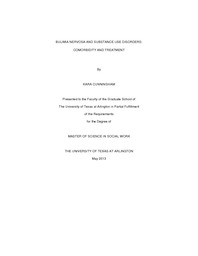
ATTENTION: The works hosted here are being migrated to a new repository that will consolidate resources, improve discoverability, and better show UTA's research impact on the global community. We will update authors as the migration progresses. Please see MavMatrix for more information.
Show simple item record
| dc.contributor.author | Cunningham, Kara | en_US |
| dc.date.accessioned | 2013-07-22T20:14:11Z | |
| dc.date.available | 2013-07-22T20:14:11Z | |
| dc.date.issued | 2013-07-22 | |
| dc.date.submitted | January 2013 | en_US |
| dc.identifier.other | DISS-12088 | en_US |
| dc.identifier.uri | http://hdl.handle.net/10106/11842 | |
| dc.description.abstract | This paper will demonstrate the connection in the professional literature that individuals who suffer from bulimia nervosa also have a high chance of suffering from a substance use disorder. Although, the literature supports this comorbidity issue, there is a lack of research on the treatment of both disorders simultaneously. The purpose of this study is to determine if clinical professionals are screening for substance use disorders among their clients who are being treated for eating disorders. The primary questions for this research project are: 1) What portion of eating disorder professionals recognize substance use disorders when treating clients who are suffering from bulimia nervosa? 2) What portion of eating disorder professionals diagnose substance use disorders when treating clients who are suffering from bulimia nervosa? 3) What portion of eating disorder professionals treat substance use disorders when treating clients who are suffering from bulimia nervosa?" This question leads to several sub-questions such as a) If eating disorder professionals do treat bulimia and substance use disorder, do they treat them simultaneously and b) If eating disorder professionals do not treat substance use disorders, do they refer the clients somewhere else? Methods The researcher conducted an online survey to determine if clinicians who are treating clients with eating disorders diagnose and treat substance use disorders simultaneously. The survey was sent to 407 professionals. Eighty-four clinicians participated in the survey. Information was gathered on the clinician's demographic and clinical background. Additionally, questions were used to determine their primary treatment approaches. Moreover, data was gathered about the clinician's general clientele including, age, gender, type of eating disorder, etc. Results Upon completion, the researcher analyzed and compiled the information to determine the following results. The ages of the clinicians ranged from age 26-72, with an average age of 46. Over 96% of the participants were Caucasian females. Just over 90% stated that their primary employment setting is Private Practice.. Clinicians were asked, "Which eating disorder is most prevalent among your clients?" The answers to this question were evenly distributed across three types of eating disorders, anorexia nervosa (25%), bulimia nervosa (26.1%), and EDNOS (eating disorder not otherwise specified) (39.8%). Finally, 77% of clinicians stated that they screen eating disorder clients during the first session to determine if they also have a substance use disorder. Of the participants, 15.5% believe that they are "very skilled" and are an expert at treating substance use disorder. In addition, the majority (67.9%) said that they are "somewhat skilled" and 16.7% said that they were "not skilled" at treating substance use disorders. The results of this survey showed that over half (57.1%) of the clinicians say that they treat both bulimia and substance use disorders at the same time.Conclusion The information from this survey provided valuable information to the field of eating disorders. This information includes: 1) the eating disorder EDNOS is a growing diagnosis, 2) individuals who are diagnosed with eating disorders are either younger (5-10 years old) or older (30-40 years old) individuals. Finally, eating disorders are also affecting more men. The findings of this study suggest that there is a need for more education, training and screening tools when dealing with the comorbid issue of eating disorders and substance use disorders. | en_US |
| dc.description.sponsorship | Blakey, Joan | en_US |
| dc.language.iso | en | en_US |
| dc.publisher | Social Work | en_US |
| dc.title | Bulimia Nervosa And Substance Use Disorders: Comorbidity And Treatment | en_US |
| dc.type | M.S. | en_US |
| dc.contributor.committeeChair | Blakey, Joan M. | en_US |
| dc.degree.department | Social Work | en_US |
| dc.degree.discipline | Social Work | en_US |
| dc.degree.grantor | University of Texas at Arlington | en_US |
| dc.degree.level | masters | en_US |
| dc.degree.name | M.S. | en_US |
Files in this item
- Name:
- Cunningham_uta_2502M_12088.pdf
- Size:
- 7.250Mb
- Format:
- PDF
This item appears in the following Collection(s)
Show simple item record


